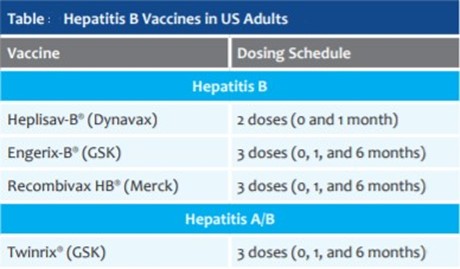A nurse is teaching a group of middle age adults about various types of hepatitis.
What statement by one of the group members indicates correct understanding of the differences?
“I can get sick with hepatitis A from unprotected sex.”.
“I need to receive 3 doses of hepatitis B vaccination to assure protection.”.
“I can’t get hepatitis C from IV drug use, but hand hygiene after toileting is essential.”.
“There is no vaccination for hepatitis A, but I can take 8-12 weeks of oral medication to cure it.”.
The Correct Answer is B
.“I need to receive 3 doses of hepatitis B vaccination to assure protection.” This statement indicates that the person understands that hepatitis B is a serious infection that can be prevented by vaccination.
Hepatitis B vaccine is given as a series of 3 shots over a period of 6 months.

Choice A is wrong because hepatitis A is not usually transmitted through unprotected sex, but through ingestion of contaminated food or water or direct contact with an infected person.
Hepatitis A can also be prevented by vaccination.
Choice C is wrong because hepatitis C can be transmitted through IV drug use, as well as blood transfusions, organ transplants, needlestick injuries, and sharing personal items such as razors or toothbrushes with an infected person.
Hepatitis C can cause chronic liver disease and there is no vaccine for it.
Choice D is wrong because there is a vaccine for hepatitis A, which can provide lifelong protection against the infection.
Hepatitis A usually does not require treatment and most people recover completely within a few weeks. There is no specific medication to cure hepatitis
Nursing Test Bank
Naxlex Comprehensive Predictor Exams
Related Questions
Correct Answer is C
Explanation
This action would cause the nurse to intervene because it increases the risk of choking and aspiration for a client with dysphagia, which is difficulty swallowing. The nurse would instruct the UAP to feed the client small amounts of food slowly, allowing time for chewing and swallowing.
Choice A is wrong because offering thickened liquids is a safe practice for a client with dysphagia. Thickened liquids allow for easier swallowing and less choking, thus decreasing the chance of aspiration.
Choice B is wrong because placing the client in an upright position is also a safe practice for a client with dysphagia. This position helps prevent food from entering the airway and facilitates swallowing.
Choice D is wrong because allowing ample time between bites is another safe practice for a client with dysphagia. This helps the client avoid feeling rushed or overwhelmed and reduces the risk of aspiration.
Correct Answer is B
Explanation
This is because anti-embolism stockings are designed to prevent swelling and blood clots in the legs by applying graduated compression, which is tighter around the ankle and looser as it moves up the leg. Applying the stockings in the morning before any swelling occurs ensures a proper fit and optimal blood flow.
Choice A is wrong because massaging the legs can dislodge a blood clot and cause a pulmonary embolism.
Choice C is wrong because wetting the stockings can make them harder to apply and reduce their effectiveness.
Choice D is wrong because removing the stockings before bathing can increase the risk of swelling and clotting, and applying fresh ones afterward can be difficult and uncomfortable.
Whether you are a student looking to ace your exams or a practicing nurse seeking to enhance your expertise , our nursing education contents will empower you with the confidence and competence to make a difference in the lives of patients and become a respected leader in the healthcare field.
Visit Naxlex, invest in your future and unlock endless possibilities with our unparalleled nursing education contents today
Report Wrong Answer on the Current Question
Do you disagree with the answer? If yes, what is your expected answer? Explain.
Kindly be descriptive with the issue you are facing.
